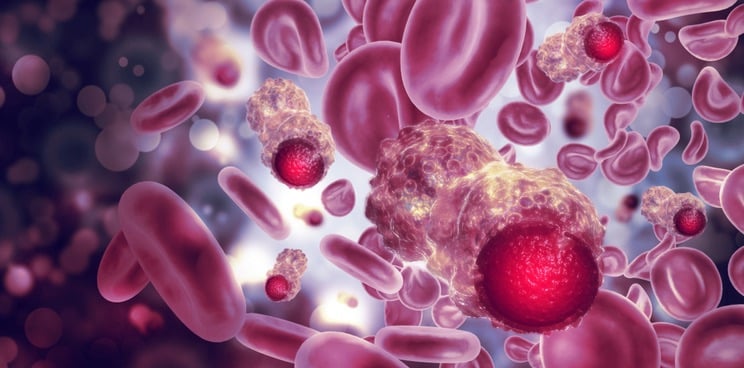A new case of blood cancer gets diagnosed approximately every three minutes in Western countries. Although the last three decades have seen considerable progress in treating blood cancers, this heterogeneous group of diseases still claim around 150,000 lives annually in Europe and the U.S. We dig into the extensive research being done today to meet the unmet medical need in this space.
Blood cancers – also known as hematological malignancies – are a result of abnormally proliferative blood cells, which ultimately alter the function of the human blood and immune system. In contrast to solid tumors, which result from abnormal cells multiplying in a localized manner, blood cancer tumors circulate throughout the body.
The complex landscape of heterogeneous blood cancers
Leukemias, typically made of cancer cells arising in the bone marrow, are the most common type of blood cancers. Accounting for almost half of all cancers in children, but less common in adults, these cancers can be acute or chronic.
In contrast, lymphomas – blood cancers originating from blood cell precursors in the lymphatic system – are less prevalent in children, but common in adults. This group consists of non-Hodgkin’s lymphoma, of which diffuse large B-cell lymphoma (DLBCL) is a common and aggressive subtype, and the rarer Hodgkin’s lymphoma.
The last type of blood cancers are the myelomas, of which multiple myeloma form a particularly aggressive subtype.

According to Stefano Cairo, Senior Global Scientific Director at Champions Oncology, a global technology-driven oncology research company: “Blood cancers are extremely heterogeneous: they can vary heavily in terms of symptoms, prognosis, progression and treatment resistance. In leukemia alone, over 200 different subtypes have been identified.”
“As blood cancers are characterized by a large variety of molecular alterations and important interactions within the tumor microenvironment, they are difficult diseases to study. And, unlike localized solid tumors, blood cancers cannot be treated with surgery, which makes them challenging to treat.”
Chemotherapies, involving a wide range of systemic anticancer chemicals, are the standard of care in this space. However, targeted therapies designed to specifically disrupt cancer cell growth and survival, with lesser side effects than chemotherapy, have demonstrated clinical benefit and will likely become a preferred option over the years.
Rituximab, which targets proteins found on the surface of blood cancer cells, is one such monoclonal antibody commonly used in the front-line treatment of aggressive blood cancers.

“Since 2017, highly specialized targeted treatments known as chimeric antigen receptor T-cell (CAR-T) therapy have caused a stir in the hematological world,” shared Mara Gilardi, Subject-matter-expert in immuno-oncology at Champions Oncology. “CAR-Ts involve genetic modification of patient cells, training them to recognize and destroy cancer cells in a targeted manner.”
To date, five CAR-Ts targeting blood cancers have been approved by the US Food and Drug Administration. Several more CAR-Ts are in the pipeline.
A multi-omics research toolkit to study blood cancers
The targeted therapies in the market today have been decades in the making. The extensive research on the cancer pathophysiology has helped identify specific biological characteristics, in the form of biomarkers. Biomarkers have aided patient diagnosis and stratification, understanding cancer prognosis, and the design and development of targeted treatments.
Recent technological advances have further facilitated this search for targeted therapies. Today, researchers have a broad portfolio of tools to choose from to help characterize the different molecular aspects of blood tumors.
“The tools we have today can help examine cellular phenotypes (such as through cytometry or multiplex chemistry), genetic and epigenetic alterations (using deep RNA and DNA sequencing), protein expression and enzymatic activity (using proteomic and metabolic analysis), and more,” said Cairo.
These profiling tools can also be combined into a multi-omics approach, with bioinformatics and machine learning being used to integrate and interpret the different biological data outputs. This can help researchers obtain holistic insights with high granularity uncovering biological phenomena, explained Gilardi.
“Our team at Champions often integrates all of these datasets through a proprietary machine learning algorithm, called ‘pharmaco-phenotypic-multi-omic (PPMO) integration. This helps to deconvolute tumor complexity and identify biomarkers predictive of tumor response to treatment, which will eventually help optimize treatment selection and translate into better outcomes.”
Choosing the correct blood cancer disease model
Equally crucial to drug discovery and testing is the choice of disease model.
“Oncology clinical trials see one of the highest failure rates in the healthcare industry, despite the tested drugs having passed preclinical testing,” reminded Gilardi. This highlights the importance of every decision – including model selection – made in the preclinical stages enabling successful translation from the lab to the clinic.
“An appropriate preclinical model is one that is well characterized and representative of the disease, both at the molecular level, and from a treatment history standpoint,” she continued. “A blood cancer disease model needs to mirror patient mutations and the tumor immune-microenvironment to accurately capture patient physiology and provide realistic treatment responses.”
Model selection is hence a complex decision, with companies often consulting with experts to optimize their experimental strategy.
Among pre-clinical models, a relevant model type for blood cancer research involves patient-derived primary cells. These enable ex vivo assays, which help analyze blood cells from patients, essentially helping recapitulate patient patho-physiology in a Petri dish.
Xenograft models are another option, allowing for in vivo analysis of engrafted cancer cells from a patient within an animal model (often immunodeficient mice). These models recapitulate tumor growth at an organism level, therefore retaining the complexity of the interaction with the host.
Xenograft models can be either cell line-derived (CDX), made from commercially available cell lines, or patient-derived (PDX), based on direct implantation of patient tumor cells.
“Moreover, in early drug discovery and development, a combination of models can also be used sequentially,” noted Gilardi. “Ex vivo assays can be used for quick, cost-effective high throughput screening of targets, followed by research on in vivo animal models replicating the tumor microenvironment, for patient-relevant information.”

A promising route to tackling today’s challenges
Despite the wide variety of tools available to study blood cancers today, Cairo emphasized that a major challenge remains: “The inherent heterogeneity in these cancers means there is a real need for preclinical models robustly reflecting the patient situation. The only way forward is by continuously monitoring and validating that the preclinical models we propose are capable of translating results to the clinic.”
“At Champions, we leverage our close collaborations with hospitals and research institutions that treat patients on a regular basis to ensure that our models, the annotated information, and the insights they provide, stay clinically and biologically relevant.”
This empowers Champions to offer a range of well-characterized models ranging from primary cells, CDX and PDX, suitable for pharmacology and multi-omics analyses. To evaluate and select from the different models on offer, researchers can also leverage Champions’ proprietary Lumin bioinformatics data platform.
Sharing a recent success story where Champions helped a client test the anti-tumor effect of two of their preclinical CAR-Ts targeting DLBCL, Gilardi elaborated, “Our clients leveraged the detailed data on patient treatment histories, genetic make-up, and drug response data available on the Lumin platform.”
“By accessing this knowledge with the support of our expert scientists, our partners were enabled to select both the best experimental strategy and the most suitable PDX models consistent with their target patient population.
“Upon CAR-T administration in our models, data results exhibited tumor regression, showcasing the efficacy of both types of CAR-Ts. It has been an exciting opportunity to support our partners in gathering early evidence that illustrates CAR-Ts’ promise in treating DLBCL patients in the future.”
Today, Champions hosts one of the largest portfolio of preclinical platforms to model and study hematological malignancies. Looking to the future, Cairo shared, “The team at Champions hopes to enable full exploration of the molecular complexity of hematological tumors and lead the way towards developing novel therapeutics and diagnostics to serve the end goal of better patient outcomes.”
To partner with Champions Oncology and access their comprehensive well-characterized hematological oncology models, click here.
If you are attending Tumor Models London or ASH’22 in December, visit booth 323 to check out the Champions exhibit and connect with their experts.
Images courtesy of Champions Oncology and Shutterstock.





